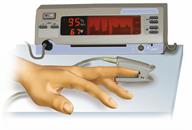Measuring Oxygen Levels Using a Sensor (Pulse Oximetry): What to Expect

Pulse oximetry is a way to measure the oxygen level in your blood without a blood test. It uses a sensor called a pulse oximeter. It also tracks your heart rate.
A pulse oximeter can show you:
How much oxygen is in your blood.
How well oxygen therapy or other treatments are working.
How well blood is flowing to other parts of your body.
Your oxygen level when you're active.
What are the benefits?
-
You don't need to do a blood test.
-
The test doesn't hurt.
-
You can watch your oxygen level all the time or as needed.
-
If you keep a pulse oximeter on all the time, an alarm will tell you if your oxygen level gets too high or too low.
What are the risks?
Your health care provider will talk with you about risks. You may get skin sores if the sensor is left in the same spot for too long. But this is rare.
What happens during the test?
What can I expect after?
- You should have the results right away. They're given as a percent. Ask your provider what a normal percent is for you.
- If your results are low, you may need to use oxygen.
What can make the results less accurate?
Pulse oximetry depends on how much light is absorbed by your skin. It may be less accurate if:
You're wearing dark nail polish or fake nails.
You have very dark skin.
You shiver or move too much.
You're in a room with bright lights.
You smoke and have done so for a long time.
You've recently breathed in smoke or carbon monoxide.
- You have certain conditions, such as:
Cool skin or poor blood flow to the area where the sensor is placed.
Sweating or very warm skin in the area where the sensor is placed.
Anemia. This is when you don't have enough red blood cells in your body.
Polycythemia vera. This is a disease that affects the spongy center of your bones (bone marrow). It causes high levels of red blood cells, white blood cells, and platelets.
If a more accurate result is needed, you may have a blood test done.
This information is not intended to replace advice given to you by your health care provider. Make sure you discuss any questions you have with your health care provider.
